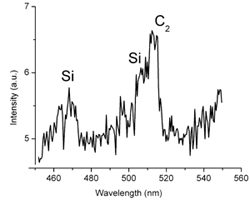Femtosecond Laser Self-Channeling can provide a high energy-density source of light at the kilometer range by creating a self-guided
filament of light, with high intensity (1x1014 W/cm-2) and a diameter of 100 μm in the atmosphere. Combined with LIBS, sensing at
distance over hundreds of meters is possible and LIBS becomes Filament-Induced Breakdown Spectroscopy (FIBS).
Few research studies have shown the ability of FIBS to detect explosives, but never at the residue level. The principal issue is the characterization of spectral signatures of energetic samples. Looking at the composition, atomic (C, H, O, N) and molecular (C2 and CN in some samples) signals are expected. But atmospheric signal from the excitation of nitrogen and induced plasma chemistry (creation of CN radicals with the atomic carbon). So new protocols of detection of energetic, and more generally, organic sample in FIBS configuration are defined to enhance the attribution of the spectra.

